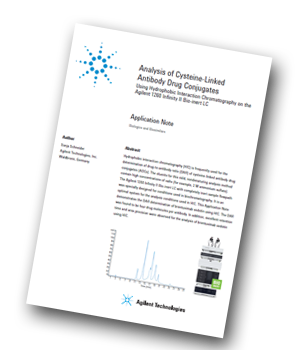In this application note from Agilent Technologies hydrophobic interaction chromatography (HIC) is used for the determination of the drug-to-antibody ratio (DAR) of a cysteine-linked antibody drug conjugate (ADC).

 Abstract
Abstract
The eluents for this mild, nondenaturing analysis method contain high concentrations of salts (for example, 2 M ammonium sulfate). The Agilent 1260 Infinity II Bio-inert LC with completely inert sample flowpath was specially designed for conditions used in biochromatography. It is an optimal system for the analysis conditions used in HIC.
This application note demonstrates the DAR determination of brentuximab vedotin using HIC. The DAR was found to be four drug molecules per antibody. In addition, excellent retention time and area precision were observed for the analysis of brentuximab vedotin using HIC.
Introduction
ADCs are monoclonal antibodies (mAbs) to which a cytotoxic small molecule drug is chemically linked. Compared to their corresponding antibodies, the structure is more complex and heterogenous. The average number of drugs conjugated to the mAb is one of the most important quality attributes of an ADC because it can directly affect safety and efficacy. The drug-to-antibody ratio (DAR) determines the amount of payload that can be delivered to the tumor tissue. The analysis used to determine DAR depends on the chemistry used for the linkage of the drug to the antibody. Cysteine-linked ADCs such as brentuximab vedotin are generated after the reduction of the interchain disulfides, resulting in free sulfhydryl groups that can be conjugated to specific maleimide linkers. The number of free sulfhydryl groups limits the number of defined positions for the drug to be conjugated, resulting in a mixture of zero, two, four, six, and eight drugs per antibody. In contrast to lysine-conjugated ADCs, the heterogeneity is significantly reduced in cysteine-conjugated ADCs, enabling the analysis of DAR using HIC. HIC is the reference technique to separate the ADC molecules loaded with different numbers of drugs per antibody. The relative hydrophobicity increases with the drug load of the ADC because the small molecules attached to the mAb are often relatively hydrophobic. Therefore, HIC is perfectly suited to monitor the DAR.
Results and Discussion
Two samples were analysed using HIC on the 1260 Infinity II Bio-inert LC with a ternary gradient including
isopropyl alcohol that supports the elution of the proteins from the HIC column. The HIC analysis allowed both the characterization of the distribution of drug-linked species as well as the determination of the DAR. Although the interchain disulfide bridges are disrupted and occupied with the conjugated drugs, the combination of covalent linkages and noncovalent forces between the antibody chains are sufficient to maintain the mAb in an intact form during the analysis. This is due to the mild, nondenaturing conditions of hydrophobic interaction chromatography, making it ideal for the analysis of ADCs.
Conclusion
An Agilent 1260 Infinity II Bio-inert LC was used to show the DAR analysis of brentuximab vedotin using HIC. The determination of DAR is one of the most important quality attributes for ADCs. Cysteine-linked ADCs are frequently analysed using HIC. The buffers used in this type of chromatography are highly corrosive due to the high amount of salt added to the mobile phase. These conditions are challenging for standard stainless steel instruments. The 1260 Infinity II Bio-inert LC has a completely inert sample flowpath, and all capillaries and fittings throughout the multisampler, multicolumn thermostat, and detectors are completely metal-free. With these materials, the 1260 Infinity II Bio-inert LC is optimally suited for the conditions used in biochromatography. The 1260 Infinity II Bio-inert LC showed optimal results for the DAR determination of brentuximab vedotin with stable and precise RTs and areas.




